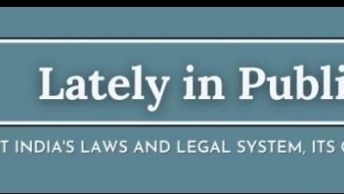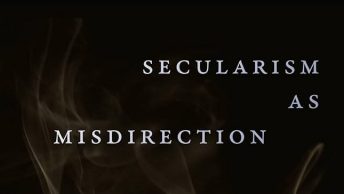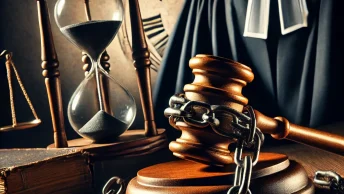In a recent post, V. Venkatesan draws attention to Abhishek Singhvi’s thoughts on the perennially controversial issue of judicial appointments in India. While I agree with the general comments made in that post by Venkatesan, I seek here to respond to a specific point. In his piece, Singhvi raises the following question:
“[T]he demand for a “broadbased” commission with political and other elements external to the judicial family as its members has to be viewed in the context of the larger issue of judicial independence. Such a commission would be nothing more than another mixed collegium. If there is bargaining or pulls and pressures within the judicial fold, it will not only increase manifold but also be more public in such
a commission. Over time, the cherished virtue and value of judicial independence would be undermined. One cannot brush aside the fact that despite warts and all, India remains an unparalleled example of constitutionalism amid the wrecks and ruins of democracy that litter the South Asian (and global) landscape of newly independent nations. To a large measure this is because of fierce judicial independence, despite aberrations at the individual level. Can we afford to risk it with the political and other classes having a direct say in judicial disciplining?”
Singhvi’s argument seems to be: if it isn’t broken, do we need to fix it? As V. Venkatesan points out, a number of commentators and observers have pointed out that the present system is riddled with several problems (even it is not broken yet), and is in dire need of fixing. Singhvi’s argument seems to be that when viewed comparatively, the Court’s overall assessment is positive, and this should make us think about changing its institutional features. This seems to a strange argument – firstly, it is not at all clear that there is a corresponding link between the Court’s overall record and the manner in which judges are currently appointed. More specifically, it has not been established that the Court has done better in the last decade or so since it began appointing its own members, than at previous points in its history when its members were appointed with inputs from a broader set of constitutional actors. To make this argument, Singhvi would have to argue that the judicial appointees over the last decade have been qualitatively better than prior judicial appointees, which is a tough argument to sustain empirically. Secondly, the Court’s overall track record owes more to its achievements in periods when appointments were made under older systems than directly to appointments made under this new system. Indeed, as has often been pointed out, the appointments of some of its most well regarded judicial members were initially perceived as not being indicative of judicial independence (recall here Soli Sorabjee’s criticism of Justice Krishna Iyer’s initial appointment which he later famously recanted by submitting his admiration for Justice Iyer’s overall record as a Supreme Court judge). So, it is not clear that changing the current appointments system will have a clearly negative effect on the overall independence and efficacy of the system.
Singhvi also appears to believe that having a broadbased system will necessarily lead to the undermining of judicial independence. It is not clear why this should be so, though one can agree that there is a need to design the process carefully. So, for instance, we should be skeptical of any approach which seeks to import the current process of appointing judges in the U.S. into India, given that that system seems to have huge problems as acknowledged by U.S. scholars and judges. This is so despite the fact that the last two times the process was in place (in the appointments of Chief Justice Roberts and Justice Alito), it avoided some of the more extreme patterns that were so characteristic of earlier appointments (the glaring example being the appointment of Justice Clarence Thomas). However, no one in India is suggesting that model as an inspiration. Instead, the model that has often been proposed in India is similar to what has been in force in South Africa under its new constitutional regime for over a decade.
A proper assessment of the South African model of judicial appointments would require a long paper – here, I seek to point out its broad features in a bid to raise the question whether we should be as dismissive of such a measure as Singhvi clearly is. The South African Judicial Service Commission’s members include the following:
* The South African Minister of Justice
* The Chief Justice of South Africa
* Two practicing advocates
* Two practicing attorneys
* Six members from the South African National Assembly (including three from opposition parties)
* Four members from the National Council of Provinces
The South African Judicial Service Commission has been in place since 1994, and this link provides details of the first set of interviews conducted by it to appoint the members of the South African Constitutional Court. Going over these interviews, one is struck by the contrast with the questions posed to American judicial appointees, and it is clear that the South African process seeks to (and does) avoid the problematic aspects of that system. By making the transcript of the interviews available publicly, there is an element of transparency which aids the stature of the judiciary in South Africa, instead of impeding it. The functioning of the JSC has not been without controversy, however, and as is to be expected, some of its decisions have been controversial, inviting debate and discussion about the correctness of at least some of those decisions. In particular, there has been debate about whether the interviews conducted by the JSC should be open to the public, raising concerns similar to what Singhvi seems to share. This is an engaging and interesting analysis of the overall efficacy of the JSC by a prominent South African legal journalist, who makes a strong case for retaining the public element of the proceedings of the JSC:
“The great conundrum about the immense power wielded by an unelected judiciary can only be resolved if judges are held accountable, although of course this has to be done in a subtle and complex way, including the system of precedent and collegiality. One of the most visible manifestations of this accountability to the ordinary public, is the moment when a candidate is interviewed and asked about his or her background, or for views on important questions like sentencing perhaps. There is a legitimate and powerful public interest in who gets appointed as a judge, and to keep the public from these hearings would be to inhibit democratic development. … And of course, in conclusion, we should never forget that the greatest protection from threats to independence from the executive must surely come from the exercise of public and media scrutiny.”
The system of judicial appointments in South Africa is certainly worth exploring seriously to see if it may have insights and practical measures of value for the current debate over the issue in India. Singhvi may well be justified in displaying the obvious pride he has in the record of the Indian judiciary. However, such pride must not lead to the unfortunate corollary of a sense of parochialism which prevents us from learning from comparative experience in a bid to improve (or maintain, depending on what your take on the court is) the institutional efficacy and status of the higher judiciary in India.






Arun, I found both your posts on appointing Judges, and the blogs very instructive.
On the issue of appointing Judges, I would just add that Justice J.S.Verma, the author of the Advocates-on-Record Judgment in 1993 has now publicly regretted the judgment. “Appointment is now a disappointment”, is what he has famously said in one of the meetings held in Chennai.
You suggested an empirical analysis of the pre-1993 and post-1993 appointments. Doubtless, it would be a challenging exercise. But off-hand, Mr.K.K.Venugopal, senior advocate has said in the pre-1993 days, we had Patanjali Sastri, Vivian Bose, Justice Bhagwati, Subba Rao and Justice Krishna Iyer. The post-1993 appointments speak for themselves, as a number of examples could be cited of Judges, considered deviant, incompetent, and corrupt.
The posting of the interview on legal blogs, even if belated, is welcome. I never imagined that blogs like this could be so beneficial. Please post similar stuff, despite your teaching pressures!